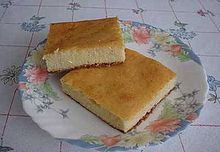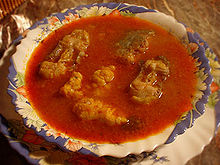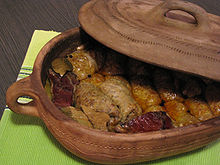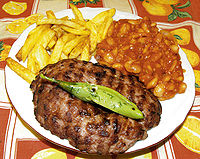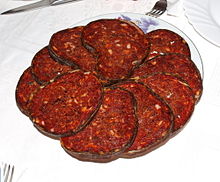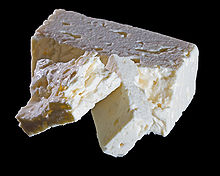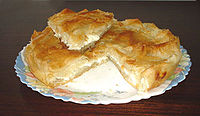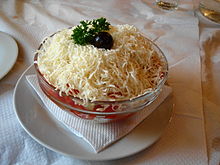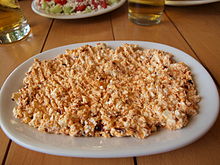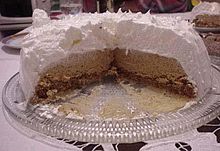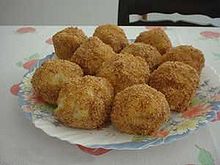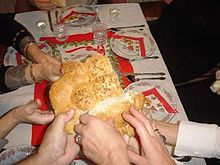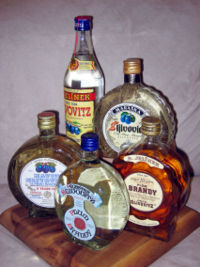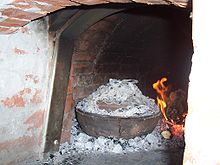- Serbian cuisine
-
Part of a series on the Culture of Serbia 
Arts Literature · Philosophy · Music · Painting and sculpture · Theatre, Opera, Ballet · Cinema Traditions Architecture · Cuisine · Folklore · Dress · Kinship · Dances Artists Actors · Composers · Painters · Epic poetry · Sculptors · Writers Monuments Fortifications · Museums · Religious · Serbian Cultural Heritage · UNESCO WHS Other Serbian language · Famous Serbians · Media · Serbian Academy of Sciences and Arts · Sport · Religion
Serbia Portal
Part of a series of articles on
Serbs
 Former Yugoslavia:
Former Yugoslavia:
Serbia (Kosovo • Vojvodina)
Bosnia & Herzegovina (RS)
Croatia
Republic of Macedonia
Montenegro
Slovenia
Other:
Albania · Greece · RomaniaAustria · France · Germany
Hungary · Italy · Sweden · Switzerland
United Kingdom
North America
Canada · United States
Oceania
Australia · New Zealand
South America
Argentina · Brazil · ChileReligion
(Slava · Christmas traditions)
Kinship · Clans
Art · Architecture · Music · Cinema
Costume · Symbols
Literature · Epic poetry
Cultural Heritage sites
Sport · Cuisine · DancesRelated nationsSerbian cuisine (Serbian: српска кухиња / srpska kuhinja) is a heterogeneous cuisine, sharing characteristics of the Balkans (especially former Yugoslavia), the Mediterranean (especially Greek), Turkish, and Central European (especially Austrian and Hungarian) cuisines.
The national dishes include; Pljeskavica (hamburger), Ćevapčići (grilled minced meat), and Sarma. The national drink is the plum brandy Slivovitz.
Serbian food is characterized, not only by elements of Serbia, but of former Yugoslavia as a whole. Peasantry has greatly influenced the cooking process. During the centuries under Ottoman rule, the Balkans received influences of the rich oriental cuisine, some of the most traditional dishes have common roots with those of Greece and Turkey. The centuries under Austro-Hungarian Empire richly influenced, especially in desserts. The spectra of Yugoslavia has enriched all of the modern successor state's national cuisines.
In recent times the Serbian diaspora has spread the cuisine across the world.
Contents
History
William, archbishop of Tyre, who visited Constantinople in 1179, described the Serbs: "They are rich in herds and flocks and unusually well supplied with milk, cheese, butter, meat, honey and wax".[1]
The first published cookbook in Serbia is Pata's Cookbook (Patin kuvar), written by Spasenija Pata Marković in 1907; the book remains in publication even today.[2]
Overview
Most people in Serbia will have three meals daily, breakfast, lunch and dinner, with lunch being the largest in the Mediterranean fashion. However, traditionally, only lunch and dinner existed, with breakfast being introduced in the second half of the 19th century.[3]
It has unique mix of various traditions; Serbian confectioneries often offer koljivo, baklava, nut roll and sachertorte.
A number of foods which are simply bought in the West, are often made at home in Serbia. These include rakija (fruit brandy), slatko, jam, jelly, various pickled foods, notably sauerkraut, ajvar or sausages. The reasons for this range from economical to cultural. Food preparation is a strong part of the Serbian family tradition.
Meals
Breakfast
Breakfast in Serbia is an early but hearty meal, although before breakfast most people usually take a cup of coffee, in modern times maybe an espresso. With the breakfast itself either a tea, milk, milk coffee, or cocoa milk is served, pastries or bread are served with butter, jam, yogurt, sour cream and cheese, accompanied by bacon, sausages, salami, scrambled eggs and kajmak.
- Various sorts of pastries (often with cheese or meat or filled with jam) (pogačice, paštete, kifle that in Serbian usage may or may not be crescent shaped and may be sweet, but, may also be sprinkled with salt crystals, kiflice, perece, buhtle, pletenice, štapići, zemičke, djevreci) and especially often:
- Burek
- Kačamak (also Cicvara) - a type of polenta
- Popara
- Proja (cornbread)
- Eggs
- Kajgana (scrambled eggs)
- Jaje na oko (fried eggs)
- Rovito jaje (soft-boiled egg)
- Kuvano jaje (hard-boiled egg)
- Various sandwiches
- Bread with something:
- Sudžuk (also appetizer)
Soups
There are two types of soups in Serbian cuisine: standard soups called supa, and soups with roux (browned flour) - called čorba. The most common are simple pottages made of beef or poultry with added noodles. Fish soup (riblja čorba) and lamb soup (jagnjeca čorba) are considered to be delicacies.
- Goveđa supa (Consommé)
- Teleća čorba (veal ragout soup)
- Jagnjeća čorba (lamb ragout soup)
- Fisherman's soup
- Čorba od ječma i sočiva (Barley and lentil soup)
- Čorba od zelja i sira
- Čorba od spanaća, koprive ili zelja
- Čorba od boranije
- Paradajz čorba (Tomato soup)
- Čorba od luka (Onion soup)
- Ljuta krompir čorba (Spicy potato soup)
- Čorba jajaruša (egg soup)
- Škembe čorba (tripe soup)
Main course
The main course is always with meat. The main courses which are not grilled:
- Pecenje, Roasted meat (whole roasted pork, lamb and goat)
- Gulaš, (Goulash)
- Dolma (Japrak)
- Đuveč, stewed vegetables and pork meat similar to Ratatouille
- Karađorđeva šnicla (breaded rolled steak stuffed with kajmak and occasionally ham slices and cream cheese)
- Kavurma (lamb or pig intestines)
- Wiener schnitzel (Bečka šnicla)
- Moussaka (Мусака, Musaka, made with aubergines, potatoes or zucchini)
- Mućkalica (pork meat pieces prepared on grill in pepper and tomato hot sauce)
- Paprikaš (Паприкаш)(pork meat and pepper stew)
- Bećar paprikaš
- Podvarak (stewed sauerkraut usually with meat and bacon pieces)
- Prebranac, baked beans in sauce
- Sataraš, stewed vegetables, similar to Ratatouille
- Stuffed Bell peppers (punjene paprike)
- Sarma (sauerkraut rolls)
- Tripes (škembići)
- Noodles with poppy (Rezanci s makom)
- Pihtije
- Pasulj (Bean thin stew)
- Punjena paprika, peppered meat, onion and rice filled in peppers
- Punjene tikvice, stuffed zucchini
- Grašak, Peas
- Wedding cabbage, (Svadbarski kupus) (cooked sauerkraut with smoked pork meat)
- Dumplings (valjušci or flekice) with potatoes or cabbage
- Meat and vegetables cooked under sač
Roštilj (Grills)
Grilling is very popular in Serbia, and makes the primary offer of main courses in most restaurants. It is often eaten as fast food.
- Pljeskavica (hamburger) National Dish
- Ćevapčići (ground meat sticks) National Dish
- Vešalica (grilled strips of pork loin meat)
- Various sausages
- Mixed grill (mešano meso)
- Skewered kabobs (ražnjići)
- Leskovački roštilj (Leskovac grills)
- Gyros, various meats with tzatziki and Pita bread.
Appetizers
Meat products
Often made during svinjokolj:
- Čvarci, pork crisp
- Duvan Čvarci
- Slanina, salted Fatback
- Various smoked hams (pršut, pršuta, pečenica):
- Pečenica
- Užički pršut (Užice Prosciutto)
- Zlatiborska pršuta (Zlatibor Prosciutto)
- Prosciutto (pršut)
- Various sausages (kobasice):
- Head cheese (švargla)
- Hladetina
- Pastrma
Dairy Products
- Kajmak
- Kiselo Mleko, Buttermilk
- Yoghurt
- Pavlaka, heavy soured cream (smetana)
- White cheese
- Zlatar cheese
- Cream cheese
- Kačkavalj yellow sheep milk cheese (Caciocavallo)
- Brined cheese
- Feta, brined cheese of mostly sheep milk
- Sirenje, brined cheese of goat, cow or sheep milk
- Vlašić cheese (Vlašićki sir)
- Vurda, Sheep milk
- Siraz, unpasteurized cow's milk cheese
- Pule cheese, donkey milk cheese, most expensive cheese in the world
Bread and Porridges
 Soda bread
Soda bread
Bread is the basis of Serbian meals and it is often treated almost ritually. A traditional Serbian welcome is to offer the guest with just bread and salt; bread also plays an important role in religious rituals. Some people believe that it is sinful to throw away bread regardless of how old it is. Although pasta, rice, potato and similar side dishes did enter the everyday cuisine, many Serbs still eat bread with these meals.
In most bakeries and shops, white wheat bread loafs (typically 600 grams) are sold. In modern times, black bread and various graham bread variations regain popularity as a part of more healthy diets. In many rural households, bread is still baked in ovens, usually in bigger loafs. Also, the following breads and porridges are part of the traditional cuisine:
- Đevrek, ring-shaped bread-pastry
- Kačamak, made of boiled cornmeal, potato and, sometimes feta cheese or skorup (polenta)
- Pereca, baked snack of savory or sweet varieties (Pretzel)
- Pogačica, type of bread
- Masonica, bread with milk, sugar and kajmak or sirene (Popara)
- Soda bread
- Languš, deep-fried flat bread
- Mekike, deep-fried pieces of dough
- Pita, pocket flat bread
- Somun
- Lepinje
- Užice lepinje
Pies
Serbian word for pie is "pita", which should not be confused with Greek pita. Greek pita is a kind of bread and is not called pita in Serbian (a similar pastry is called lepinja), while in Serbian language, "pita" refers to a pie in general, either one eaten in Serbia or a foreign one (such as apple pie).
A Serbian pie could, in general, be called in two ways: according to its mode of preparation, and according to its filling (although not every pie is prepared with every filling). For example, a "bundevara" is a pie filled with pumpkin and could refer to either a savijača (made of rolled phyllo) or a štrudla (made of rolled dough). Both sweet and salty pies are made, and some pies could be prepared in the same way with either sweet or salty filling.
A number of Serbian pies are made with phyllo, called "kore" in Serbian language. These include:
- Burek
- Gibanica
- Savijača
- Čalabrca
- Pita
- sa sirom (cheese pie)
- sa jabukama (rolled apple pie)
- s višnjama (sour cherries pie)
- sa spanaćom (spinach pie)
- sa pečurkama / gljivama (mushrooms pie)
- krompiruša (potato pie)
- od praziluka (leek pie)
- Uvijena pita zeljanica (sorrel pie)
- Bundevara (pumpkin pie)
A common Serbian pie, not made with phyllo, is called "štrudla". To add to the confusion, it is not similar to strudel, but rather to the nut roll; but it is commonly made with poppy seeds and not walnuts. Various štrudlas include:
- štrudla s makom, also called makovnjača (nut roll with poppy seeds)
- štrudla s orasima (nut roll with walnuts)
- štrudla sa sirom (nut roll filled with cheese, eggs, and usually raisins)
Tarts and similar pies have appeared in Serbian bakeries relatively recently and are not a traditional meal.
Salads
In Serbia, salads are typically eaten with the main course and not as an appetizer. Common salads include:
- Serbian salad (српска салата, srpska salata)
- Shop salad (шопска салата, šopska salata)
- Sheepherders salad (Čobanska salata)
- Greek salad (Grčka salata)
- Russian salad (руска салата, ruska salata)
- Various simple salads (lettuce, cabbage, sauerkraut, beetroot, tomato, cucumber, carrot, potato)
- Tarator, (Таратор)
- Kisele (ukiseljene) paprike (roasted green papers with garlic and vinegar)
- Moravska salata
- Urnebes salata
Relishes
 Ajvar
Ajvar
Sweets
- Alva, flour-based and Nut-butter-based sweet confections.
- Baklava, sweet pastry made of layers of phyllo dough filled with chopped nuts and sweetened with syrup or honey.
- Kompot, pieces of fruit in sugar syrup (compote)
- Doboš Torta, five-layer sponge cake, layered with chocolate buttercream and topped with thin caramel slices.
- Jam (džem and pekmez - preserve)
- Slatko, fruits in jelly (Fruit preserves)
- Kadaif, (Knafe) sweet pastry of Kanafeh layers
- Kitnikes, jelly sweets
- Knedle (Knedle sa šljivama - also called Gomboce in Banat)
- Kuglof
- Krofne, doughnuts filled with custard, chocolate, cream or jelly (Berliner)
- Kitnikes
- Krempita (custard pie)
- Makovnjača
- Medenjaci
- Oblande (Oblatne)
- Orasnice
- Palačinke (crepes)
- Plazma torta, torta of Plazma keks
- Profiterole (princes krofne)
- Serbian Cherry pie(Pita od Višanja- sour cherries and walnuts with fillo dough)
- Salčići
- Šampita, Tasty whipped marshmallow-type desert with fillo dough crust
- Šenokle
- Šerbet
- Štrudla, layered sweet pastry
- Ratluk, sweet jelly confections (Turkish delight)
- Ruske Kape
- Reform Torte see information about torte
- Sutlijaš, rice pudding with cinnamon
- Tatlije, sweet pastry
- Tufahije
- Tulumbe
- Urmašice
- Uštipci
- Vanilice
- Vasa's torte (Vasina torta - traditional Serbian cake (torte) rich in chocolate, nut and orange flavour (see recipe in external links))
- Žito, ceremonial sweet made of wheat, walnuts and some raisins)
Ritual
- Česnica, Christmas bread
- Koljivo, boiled wheat - ritual food during slava
- Slavski kolač, prepared for slavas.
- žito, sweet prepared for slavas
Spices and seasoning
Serbian cuisine is generally lacking in spices and herbs: practically only black pepper and ground paprika are in widespread use, along with parsley used for soups.[4] Other spices sometimes used include white pepper, allspice, Coriandrum sativum, laurel, celery and clove.
Drinks
Non-alcoholic
High quality and quantity of fruit and abundance of water result in a number of high-quality fruit juices and mineral waters produced in Serbia, and being among its most widely known exports. There are few domestic carbonated soft drinks however. An interesting traditional soft drink, made from corn, now less commonly consumed is boza. Kvas is also being made by some breweries.
Serbian coffee, Turkish coffee prepared the Serbian way (домаћа кафа 'domestic coffee' or кафа 'coffee'. Especially strong coffee (without sugar and milk) is often referred to as 'Turkish' or 'black' coffee) is a traditional drink of Serbs. Tea is far less popular and mostly herbal teas are consumed, drunk on their own or as supplementary medicine.
Of dairies, yoghurt is common, as are kefir and similar varieties.
The famous Serbian Knjaz Milos mineral water is considered a national brand and can be used in any meal, also with the traditional greeting sweets "Slatko".
Alcoholic
Rakija
Of distilled beverages, the most popular are various fruit brandies called rakija. Comparatively many people brew their own rakija, which is highly prized by friends and relatives. Various kinds of rakija are named after fruit they are made of; among the most known ones are:
- Šljivovica (slivovitz, plum brandy), National Drink
- Šumadija tea,
- Lozovača (grape brandy)
- Viljamovka / Kruškovac (pear brandy)
- Klekovača,
- Jabukovača, applejack
- Stomaklija,
- Pelinkovac, (a wormwood liqueur milder than Absinthe)
Beer
Beer is widely enjoyed in Serbia, which has 14 breweries (see Beer in Serbia). Jelen pivo is usually considered to be the best.
Wine
- Prokupac
- Vranac
- Krstač
- Smederevka
- Tamjanika
Kitchenware
Some specific kitchenware for Serbia are:
See also
- Serbian culture
- Serbian slivovitz http://www.tastebrandy.com]]
External links
- RecipeSpin Includes some Serbian recipes
- PanonskiKuvar.com - Online Serbian recipes.
- Nigella.com - very good English language recipe for Vasa's Torte - delicious traditional birthday cake with origin from Paraćin, Serbia.
- SerbiaTouristGuide.com Includes Serbian recipes
- Balkan Cuisine Serbian recipes
References
- ^ William of Tyre, Historia Transmarina 20.4.
- ^ Istorija pisanja kuvara u Srbiji
- ^ Antonić, Dragomir (2006-07-23). "Царство за гибаницу" (in Serbian). Politika 33300 (Politika): p. 11.
- ^ "http://www.ekapija.com/website/sr/page/82512" (in Serbian). Ekonomist magazine. 2006-12-11. http://www.ekapija.com/website/sr/page/82512.
 Serbia topics
Serbia topicsBasic topics History Prehistoric Serbia:Roman Serbia:Middle Ages:White Serbs · Serbian Sklavinia · Medieval Serbian Principality (provinces of Rascia, Bosnia, Diocleia, Travunia, Zachlumia, Pagania) · Serbian Grand Principality · Serbian Kingdom · Serbian Empire · Ottoman Serbia
Politics Constitution · President · Prime Minister · National Assembly · Political parties · Elections · Foreign relations · Government · History · Armed Forces · Air Force · Law enforcement · Nationality law · LGBT rightsGeography Administrative:Landforms:Economy Culture Architecture · Beer · Cinema (Films) · Cuisine · Literature (Medieval) · Cultural Heritage (UNESCO sites) · Media · Music · Serbian Orthodox Church · Sport · Television · Public holidays · History · Education · Human rights (LGTB rights) · Languages · Religion · Subdivisions · Districts · Crime · Serb people (List)WikiProject • Portal • Commons European cuisine Sovereign
states- Albania
- Andorra
- Armenia
- Austria
- Azerbaijan
- Belarus
- Belgium
- Bosnia and Herzegovina
- Bulgaria
- Croatia
- Cyprus
- Czech Republic
- Denmark
- Estonia
- Finland
- France
- Georgia
- Germany
- Greece
- Hungary
- Iceland
- Ireland
- Italy
- Kazakhstan
- Latvia
- Liechtenstein
- Lithuania
- Luxembourg
- Macedonia
- Malta
- Moldova
- Monaco
- Montenegro
- Netherlands
- Norway
- Poland
- Portugal
- Romania
- Russia
- San Marino
- Serbia
- Slovakia
- Slovenia
- Spain
- Sweden
- Switzerland
- Turkey
- Ukraine
- United Kingdom
- (England
- Northern Ireland
- Scotland
- Wales)
- Vatican City
States with limited
recognition- Abkhazia
- Kosovo
- Nagorno-Karabakh Republic
- Northern Cyprus
- South Ossetia
- Transnistria
Dependencies
and other territories- Åland
- Faroe Islands
- Gibraltar
- Guernsey
- Jan Mayen
- Jersey
- Isle of Man
- Svalbard
Categories:
Wikimedia Foundation. 2010.

